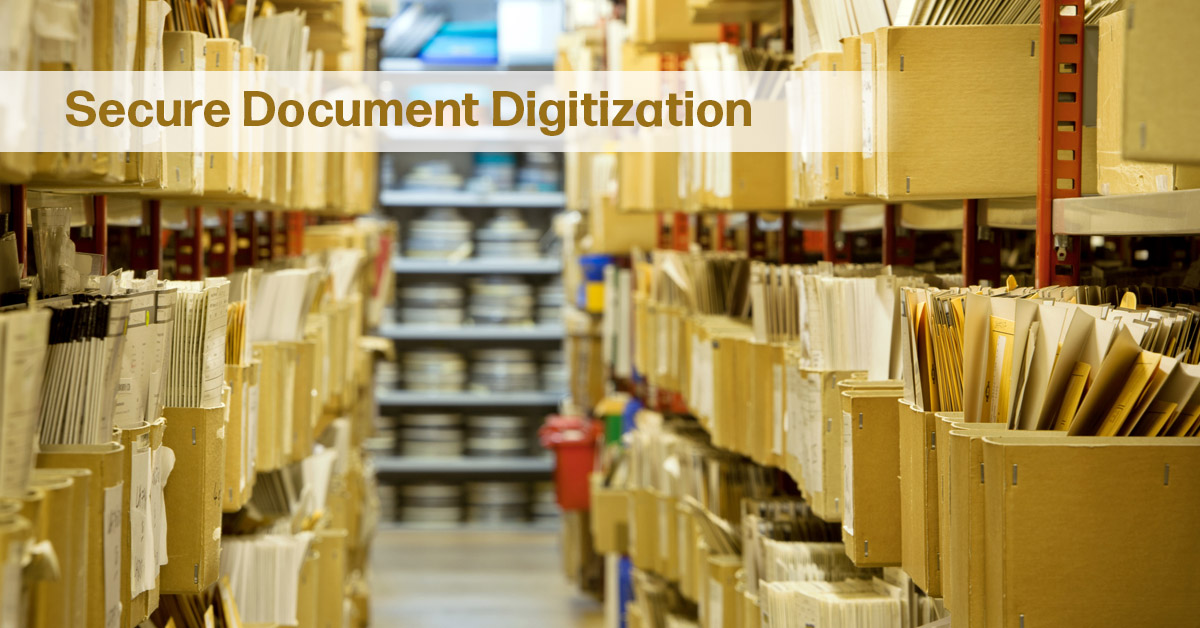In the data-driven world of modern healthcare, the shift from paper to digital systems for managing patient information is not just a trend but a necessity. As healthcare providers strive to improve patient care and streamline operations, securing patient data has never been more important. Let’s take a closer look at the importance of digitizing medical records and how it enhances data security.
The shift from paper to digital
For decades, medical records were maintained on paper, stored in filing cabinets or racks of hanging medical files, and managed manually. While many healthcare organizations have now implemented an electronic healthcare record system, many still have file cabinets, rooms, and even warehouses full of historical paper medical records.
The security risk of traditional paper medical records
While paper medical records served their purpose at one time, they now have several drawbacks:
- Vulnerability to physical damage: Paper records are susceptible to damage from fire, water, and other environmental factors.
- Risk of loss or theft: Physical files can be easily misplaced or stolen, leading to potential breaches of sensitive information.
- Limited accessibility: Retrieving paper records can be time-consuming and labor-intensive, hindering efficient patient care.
- No secure audit trail: Accessing paper records doesn’t provide a secure access trail as to who and when the medical record was accessed.
Six key benefits of digitizing medical records
The advent of electronic health records has revolutionized the way medical information is stored and accessed. Digitizing historical patient records offers numerous advantages over traditional paper-based systems, and we’ll take a closer look at six of them.
1) Improved patient care
Digitizing patient records enhances the quality of care provided by healthcare professionals. With quick access to comprehensive medical histories, doctors can make informed decisions more efficiently. This leads to a more accurate and comprehensive diagnosis, prompt treatment and intervention, and less human errors.
Digital medical records improve communication between different healthcare providers involved in a patient's care journey. This collaborative approach ensures better coordination among specialists while reducing redundancies such as duplicate tests or procedures.
2) Enhanced information security
One of the most critical concerns in healthcare is the security of patient information. Paper records are vulnerable to physical damage, theft, and unauthorized access. Digitizing patient records allows for encryption, password protection, and secure server backups, significantly reducing the risk of data breaches.
Access to these records can be restricted and monitored, ensuring that only authorized personnel can view or modify sensitive patient information. This level of security is essential in maintaining patient confidentiality and trust.
3) Better space management
The physical storage of paper records requires substantial space, which could be better utilized for patient care facilities. Hospitals and clinics often allocate entire rooms or even buildings to store vast amounts of patient files. This not only takes up valuable space but also incurs additional costs for maintenance and management.
Digitizing patient records eliminates the need for physical storage, freeing up space for more critical uses. Digital records are stored on servers or in the cloud, requiring minimal physical infrastructure. This transition not only reduces overhead costs but also allows healthcare facilities to optimize their physical resources more effectively.
4) Simplified compliance
Healthcare is a highly regulated industry, with stringent requirements for record-keeping and data management. Regulations such as the Health Insurance Portability and Accountability Act (HIPAA) mandate strict standards for the protection and confidentiality of patient information.
Digitizing patient records makes it easier to comply with these regulations. Automated audit trails can track who accessed or modified records and when, providing a clear log of all activities. This transparency simplifies compliance reporting and reduces the risk of regulatory penalties.
5) Improved record retention
Paper records can deteriorate over time, becoming illegible or damaged due to factors like environmental conditions or handling. Digitizing patient records preserves them in their original quality indefinitely, ensuring that patient histories are always accessible and intact.
Additionally, healthcare organizations often have specified time periods required for retaining various types of medical records. By digitizing medical records, the purging of records can happen more easily and in compliance with these timelines.
6) Reduced administrative costs
While transitioning from paper-based to digital records may require an initial investment, digitizing patient records ultimately leads to cost savings over time. Healthcare systems see a reduction in the administrative expenses associated with manual record management, lower storage costs as rooms or buildings of paper files are no longer needed, and less legal liabilities related to data breaches and record retention policies that aren’t in compliance.
Start a digital transformation of your historical patient records
As the healthcare industry continues to evolve, the adoption of digital technologies will play an increasingly critical role in ensuring that healthcare providers can deliver high-quality, patient-centered care. By embracing the digitization of historical medical records now, healthcare facilities can streamline their operations, protect sensitive information, make better use of physical space, adhere to regulatory requirements, and maintain comprehensive patient records over the long term.
The digitization of historical patient records is a necessary evolution, ultimately leading to better health outcomes for patients. The team of digital transformation specialists at EO Johnson have the bulk document scanning skill and horsepower to tackle even the largest healthcare digitization projects. Our team is SOC 2 Type 2 audited because we value information security as much as you do. Let’s talk about the current state of your paper medical records and how we can move you into the future.











No Comments Yet
Let us know what you think